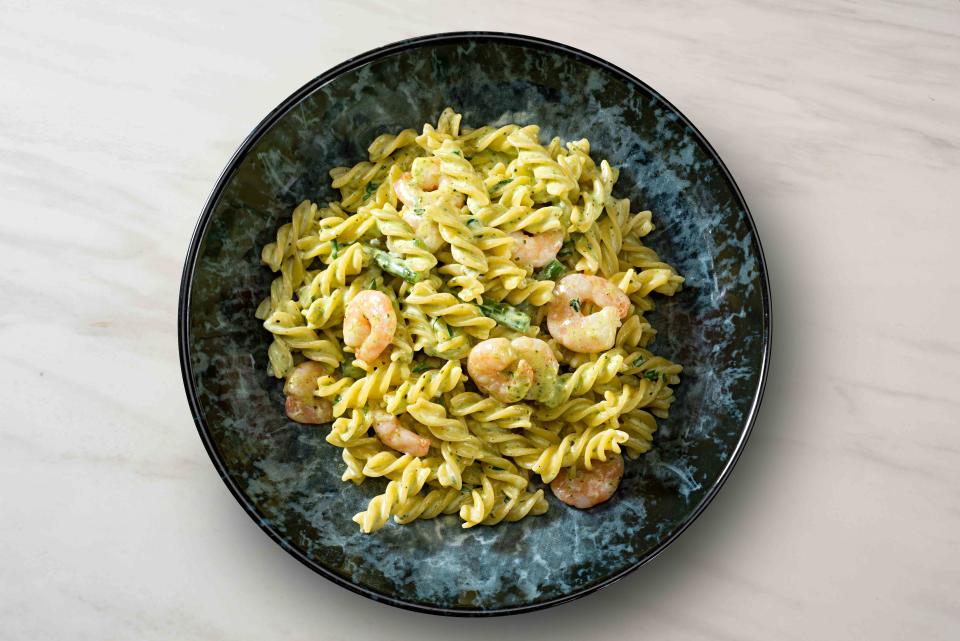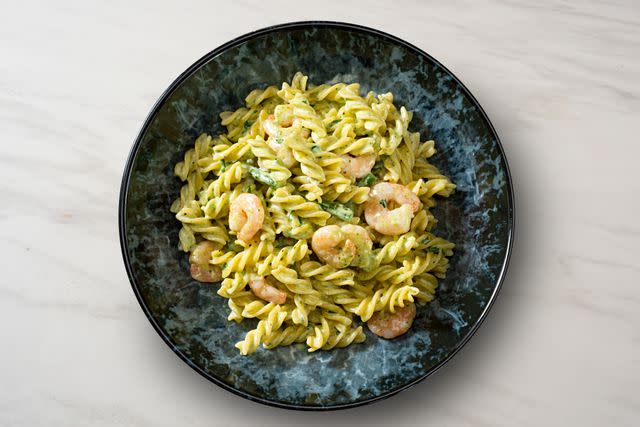Should You Be Buying More Shrimp Right Now?
Cheap, nutritious, and sometimes sustainable, shrimp might be just what your diet needs this summer—just make sure you’re shopping responsibly.

Pass the cocktail sauce, because when it comes to trendy seafood, shrimp is leading the charge. While this shellfish has been a family favorite for decades as the most consumed seafood in the U.S., more and more restaurants—including many popular chains—are highlighting this protein as an affordable luxury. What’s all the hype about? Is this inexpensive shrimp as wholesome as it seems, or are there other factors you should be aware of before making plans to hit up the peel-and-eat buffet?
Related: Are Plant-Based Meat Substitutes Healthy? What You Need to Know
What Makes Shrimp So Appealing
It’s undeniable that there’s a lot to love about shrimp. Its salty sweetness is not only delicious, but it also complements a variety of flavors and cuisines. From Italian to Mexican, Cajun to Asian, shrimp can be found around every corner of the culinary landscape. Plus, shrimp are super quick-cooking and readily available in various forms—shell on, tail on, deveined, shelled, fresh, frozen—making them the perfect choice for a busy weeknight supper.

Beyond its tasty flavor, shrimp is also highly nutritious. In 3 ounces, you’ll find an impressive 17 grams of protein. Given how trendy protein is these days, you can see why consumers can’t get enough of this shellfish. Protein helps us build healthy tissue, especially muscle, throughout the body while providing lasting energy. Shrimp also contains phosphorus, zinc, copper, selenium, choline, vitamin E, and B vitamins, including niacin, pantothenic acid, B6, and B12. These micronutrients support our immune system, bone, brain, and thyroid health, promoting efficient energy metabolism and tissue formation.
Quite possibly, the most appealing aspect of shrimp these days is its price, with the most affordable of varieties at just over $5 per pound. Compare this to the minimum $10 to $11 (and often much higher) per pound you can expect with salmon and tuna, and it’s no wonder consumers are opting for this shellfish instead. While prices on other popular types of seafood have soared with recent inflation, shrimp has remained affordable for the average middle-class consumer, increasing its appeal.
Related: 6 of the Healthiest Fish to Eat (And 4 to Avoid)
Why Is Shrimp So Cheap?
Why is shrimp so cheap? Well, the answer might not be as pleasant as we hope.
A large part of shrimp’s low price point is that much of it is harvested abroad and imported. Up to 85 percent of the seafood in the U.S. is imported, including shrimp. India, Ecuador, and Indonesia are the biggest exporters of shrimp to the U.S., sending hundreds of millions of pounds into the country every month. With these imports comes uncertain regulation: A 2011 report found that the U.S. Food and Drug Administration only tested a shocking 2 percent of all seafood imported into the country for contamination, and more recent research indicates that the majority of imported seafood products is still not closely monitored. (In early 2023, the FDA published a new report outlining how it regulates the safety of imported seafood.)
Beyond regulatory concerns, the carbon footprint of shipping these tiny crustaceans across the globe in either frozen or refrigerated storage is rather large, and that’s just one side of the sustainability concerns surrounding shrimp production and consumption: The actual production of shrimp also poses a serious environmental threat.
Much of the shrimp production abroad occurs through farming operations that can put out high volumes of the shellfish at a very low cost, often in mangrove ecosystems. Vital aquatic forests have been destroyed to make way for production facilities, with at least one-fifth of all mangroves worldwide already gone—largely due to shrimp farming—a 2012 U.N. report found. Many of these operations also pollute local aquatic ecosystems and have unethical labor practices.
Related: Sustainable Food and Drink Will Be Everywhere in 2023
Sustainability Within Shrimp Production
With this information, wild-caught shrimp certainly seems like the better option, even if it doesn’t have the same low price point of farmed shrimp. While there are still valid concerns surrounding how wild shrimp are caught—often, wild shrimp are caught using wall netting systems or trawls that catch more than just shrimp, harming other sealife—many conscientious individuals take on the task of ethical, sustainable shrimp production.
From small-operation fishermen to shrimp farmers adopting honest practices, you can find shrimp that won’t leave you with a guilty conscience. The best way of finding these crustaceans is to shop local, look at the label of what you’re buying, or speak with your fishmonger about the source of the shrimp. If you see sustainability labels on the product, that’s usually a good sign. Also, look to sites like Monterey Bay Aquarium Seafood Watch and Global Seafood Alliance for information on reputable sources and sources to avoid.
Related: The 9 Best Meat Substitutes to Add Protein to a Plant-Based Diet
For more Better Homes & Gardens news, make sure to sign up for our newsletter!
Read the original article on Better Homes & Gardens.

